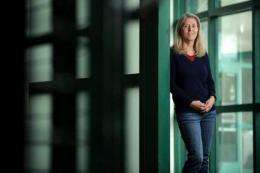Diane O’Dowd, UCI professor of developmental & cell biology, believes there should be equal incentives for effective teaching and productive research in scientific fields. Photo: Steve Zylius
(PhysOrg.com) -- UCI Professor Diane O'Dowd and others argue science teaching is not properly valued.
When biology professor Diane O’Dowd began teaching at UC Irvine 22 years ago, she says, she was handed a set of keys and a schedule: “I was told, ‘This is the class you’re going to teach. There will be 350 students. They’ll show up on this day, and you’ll give the exams at these times. Now go teach!’”
Not content to just "go teach," for the past several years O'Dowd has used hefty funding she won from a prestigious institute to develop creative, effective teaching methods for her freshman biology class. It's the type of funding she and other research professors think more should receive. No one wants to be a bad teacher, they argue, but the “publish or perish” work ethic, the tenure system, funding and other forms of recognition are structured to reward those who spend the bulk of their time in a laboratory, not a classroom.
O’Dowd and a dozen other professors from Harvard University, Yale University, the Massachusetts Institute of Technology and elsewhere have written a commentary on the subject for the Jan. 14 issue of Science magazine. They argue that university reward systems heavily favor science, technology, engineering and math research at the expense of teaching – and outline steps to change that dynamic.
The authors note that professors have two responsibilities: to generate new knowledge and to educate students. But the promotions, awards and recognition given to science professors all emphasize research, they maintain, while educational duties “have long had the derogatory label ‘teaching load.’”
O’Dowd and the others are trying to practice what they preach and have been rewarded for it. They’re all research scientists who have received substantial funding from the Howard Hughes Medical Institute to create new programs that more effectively engage students in learning science.
“We’re excited that these accomplished leaders have drawn on their experiences to take on this critically important challenge,” says David Asai, director of HHMI’s precollege and undergraduate education programs.
O’Dowd, for instance, has freshman biology students use large garden hoses and other props to play the different parts of cells and interact onstage to bring scientific processes alive.
“Every class is different, instead of being the same rote lecture you could watch 50 times on a computer screen,” she says. While it’s tough to balance active research and creative teaching, O’Dowd says, there is a payoff for the extra effort. She and her students enjoy the classes, and she’s forced to broaden her horizons beyond fruit fly research questions to think about the larger picture.
The Science piece details ways to ensure that such teaching and research are equally valued: training science faculty in best teaching practices; requiring teaching excellence for tenure and other promotions; creating peer discussion groups and cross-disciplinary programs that connect science and education faculty; winning over department chairs, deans and college presidents; and creating awards and named professorships that support teaching.
UCI’s science deans say many of these measures are in place, including mandatory teaching reviews every two to five years.
“All University of California campuses require a formal evaluation of teaching commitment and effectiveness as part of every merit or promotion consideration,” says Al Bennett, dean of UCI’s School of Biological Sciences. “Teaching is taken very seriously, and substandard performance is grounds for denying a salary increase.”
Interim physical sciences dean Kenneth Janda says, “We already do the things suggested and constantly strive to improve our teaching responsibility – even in a time of tight budget constraints.”
O’Dowd acknowledges that progress is being made. She’s encouraged that despite tough funding cuts this fall, her school kept small discussion sections of 30 students for freshman biology. They were led by grad students using innovative teaching techniques developed as part of her HHMI program.
However, O’Dowd says, challenges remain. She thinks that continuing to break down university bias against classroom instruction ultimately could benefit not just students, but professors: Teaching might become an interactive experience with more enthusiastic students – which could lead to even bigger research leaps.
“In the lab, it’s very exciting to generate new knowledge that may help treat human disease," says Dowd. "But I believe training the next generation of scientists in how to do that research is just as exciting and important.”
Provided by University of California, Irvine






















